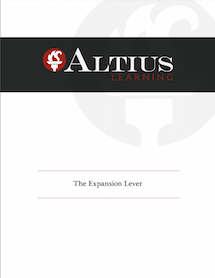Resource Center
Our resource center is rich with information to help your advisory practice.
Featured White Paper
THE EXPANSION LEVER
 One of the biggest challenges that Financial Advisors face is how to effectively turn personal relationships with affluent individuals into business relationships. It is relatively easy for Financial Advisors to put themselves in the right position to meet affluent individuals through involvement in non-profit organizations, introductions by current clients, and getting involved in the community. But transitioning to a business relationship without compromising the personal relationship is not nearly as easy.
One of the biggest challenges that Financial Advisors face is how to effectively turn personal relationships with affluent individuals into business relationships. It is relatively easy for Financial Advisors to put themselves in the right position to meet affluent individuals through involvement in non-profit organizations, introductions by current clients, and getting involved in the community. But transitioning to a business relationship without compromising the personal relationship is not nearly as easy.
The development of personal relationships with wealthy individuals and turning those relationships into clients is one of the most successful marketing approaches, found in our training for financial advisors, that Top Advisors in our industry use. In working with Top Advisors as well as interviewing them for my book, The Million Dollar Financial Advisor, (available on Amazon.com) successful FAs described the process as more of an “art” than a “science.” However, as I dug deeper to find out exactly how they accomplished that transition, I discovered they used one or a combination of these three strategies.
Our Library
The Four Levers Required to Build a Million Dollar Practice
 Creating a million dollar practice has been the “gold standard” that financial advisors aspire to reach. I remember back in 1980 when I was starting my career thinking about how hard it would be to ever reach that level of business, and being frustrated that a goal that was so important to me appeared to be so elusive. As I have since learned I wasn’t alone in my frustration: only 1% of financial advisors ever reach a million dollar practice.
Creating a million dollar practice has been the “gold standard” that financial advisors aspire to reach. I remember back in 1980 when I was starting my career thinking about how hard it would be to ever reach that level of business, and being frustrated that a goal that was so important to me appeared to be so elusive. As I have since learned I wasn’t alone in my frustration: only 1% of financial advisors ever reach a million dollar practice.
Read more about The Four Levers Required To Build A Million Dollar Practice
The Importance of The Next Generation
 For financial advisors the transfer of wealth by baby boomers to their heirs over the next 25 years is like climate change: the consequence may eventually be huge but it’s easy to ignore it right now.
For financial advisors the transfer of wealth by baby boomers to their heirs over the next 25 years is like climate change: the consequence may eventually be huge but it’s easy to ignore it right now.
This statement reflects the importance of a financial advisory practice to establish a bridge between the generations. The reality is that in the next 25 years $68 trillion will move from one generation to another and 80% of that next generation will look for new advisor. For any financial advisor practice that has the foresight to take a long-term perspective developing thoughtful practices and processes to build relationships with the next generation of their best clients this should be a very serious endeavor.
Developing Loyal Clients
 There are four levers any advisor can implement in order to reach a million dollar plus practice, and the “lever of loyal clients” is one of the most important. In his book, Cultivating the Middle Class Millionaire, Russell Alan Prince quantifies the value of a loyal client. Through his research Prince determined that a loyal client generates a significantly higher number of referrals, brings in considerable new assets, does substantially more business, and has a much higher retention rate than clients that consider themselves “satisfied, but not loyal.”
There are four levers any advisor can implement in order to reach a million dollar plus practice, and the “lever of loyal clients” is one of the most important. In his book, Cultivating the Middle Class Millionaire, Russell Alan Prince quantifies the value of a loyal client. Through his research Prince determined that a loyal client generates a significantly higher number of referrals, brings in considerable new assets, does substantially more business, and has a much higher retention rate than clients that consider themselves “satisfied, but not loyal.”
Every financial advisor who is motivated to grow their business should have the majority of their clients in the “loyal” category. The question is, how exactly do you develop a loyal clientele?
The Challenge Of Acquisition
 The acquisition of new affluent clients, and their assets, has always been the biggest challenge for financial advisors and the largest determinant of their success. The most significant insight that I have gained in our 30+ years in the business is that this challenge does not come from a lack of understanding regarding which acquisition strategy to implement – it’s the actual implementation of the known and proven strategies that causes such confusion, and unfortunately, less than stellar results. Even though countless training sessions have been conducted and a myriad of books and articles written on how to implement these strategies, most advisors still find the acquisition of new clients to be an uphill battle.
The acquisition of new affluent clients, and their assets, has always been the biggest challenge for financial advisors and the largest determinant of their success. The most significant insight that I have gained in our 30+ years in the business is that this challenge does not come from a lack of understanding regarding which acquisition strategy to implement – it’s the actual implementation of the known and proven strategies that causes such confusion, and unfortunately, less than stellar results. Even though countless training sessions have been conducted and a myriad of books and articles written on how to implement these strategies, most advisors still find the acquisition of new clients to be an uphill battle.
For example, every advisor understands that getting referrals is one of the most effective and proven acquisition strategies. There is a tremendous body of knowledge available about how to generate client referrals. Yet 90% of financial advisors do not have a consistent, proactive client referral strategy.
Building an Effective Team
 Teams of financial advisors have proliferated over the past decade in the financial services industry, and for good reason: they work. Before the mid-nineties it was the exception, not the rule, for a financial advisor to be part of a team. Teams have grown exponentially as the result of client demand and generally higher productivity.
Teams of financial advisors have proliferated over the past decade in the financial services industry, and for good reason: they work. Before the mid-nineties it was the exception, not the rule, for a financial advisor to be part of a team. Teams have grown exponentially as the result of client demand and generally higher productivity.
However, not all teams work, and there is no guarantee of productivity increases for all advisors that are part of a team. A team is like a professional marriage and many of the elements of a successful marriage apply to a successful team. The most important elements of a successful team are: having the right fit, the same commitment level, and sharing common vision and goals. When these elements come together a successful and productive
team will result.
Once those success elements are in place, taking the team to the next level involves six important practices:
The Biggest Lever
 The acquisition of new affluent clients, and their assets, has always been the biggest challenge for financial advisors and the largest determinant of their success. The most significant insight that I have gained in our 30+ years in the business is that this challenge does not come from a lack of understanding regarding which acquisition strategy to implement – it’s the actual implementation of the known and proven strategies that causes such confusion, and unfortunately, less than stellar results. Even though countless training sessions have been conducted and a myriad of books and articles written on how to implement these strategies, most advisors still find the acquisition of new clients to be an uphill battle.
The acquisition of new affluent clients, and their assets, has always been the biggest challenge for financial advisors and the largest determinant of their success. The most significant insight that I have gained in our 30+ years in the business is that this challenge does not come from a lack of understanding regarding which acquisition strategy to implement – it’s the actual implementation of the known and proven strategies that causes such confusion, and unfortunately, less than stellar results. Even though countless training sessions have been conducted and a myriad of books and articles written on how to implement these strategies, most advisors still find the acquisition of new clients to be an uphill battle.
For example, every advisor understands that getting referrals is one of the most effective and proven acquisition strategies. There is a tremendous body of knowledge available about how to generate client referrals. Yet 90% of financial advisors do not have a consistent, proactive client referral strategy.
Momentum
 The lifeblood of a healthy and growing financial services practice is the acquisition of new affluent households with assets over $250,000. The good news for financial advisors is the number of affluent and super-affluent (over $1million) households have never been higher. According to a study conducted by Russell Prince of super-affluent investors, every year 14% plan to change financial advisors. This is not good news for the advisors that will lose these clients, but is a good indicator of the potential for millionaire acquisition.
The lifeblood of a healthy and growing financial services practice is the acquisition of new affluent households with assets over $250,000. The good news for financial advisors is the number of affluent and super-affluent (over $1million) households have never been higher. According to a study conducted by Russell Prince of super-affluent investors, every year 14% plan to change financial advisors. This is not good news for the advisors that will lose these clients, but is a good indicator of the potential for millionaire acquisition.
The irony of this acquisition opportunity is that although financial advisors recognize the importance of affluent client acquisition, the number of new affluent clients that many advisors acquire every year is anemic. Our experience with many financial advisors is that the majority of them acquire fewer than four new affluent relationships a year. When the losses
of affluent clients are subtracted the net new number can be two new clients, or less.
The million dollar question is why is there a disconnect between the desire, the opportunity, and the results. I believe momentum is the answer. In order to reach early success the majority of advisors had to prospect to build the foundation of their practice. However, they become a victim of their own success as a result of servicing their clients, leaving little time
to continue prospecting.
The Power of the Monthly Contact
 The monthly client contact is one of the most powerful activities that a financial advisor can participate in. If done correctly, the monthly contact can help you develop loyal clients and serve as way to grow an advisor’s business through their existing clients.
The monthly client contact is one of the most powerful activities that a financial advisor can participate in. If done correctly, the monthly contact can help you develop loyal clients and serve as way to grow an advisor’s business through their existing clients.
Developing Loyal Clients
Having loyal clients is one of the four essential levers required for an advisor to reach the highest levels of success. A loyal client will provide referrals, consolidate all of their assets with the advisor, and never leave– that’s leverage!
One of the most important factors in developing loyalty with clients is frequent and quality communication. Based on reviewing thousands of client surveys and our decades of experience working with affluent clients, we have found that the preferred frequency of quality contact (face/voice) is monthly. We have also found that the higher the affluence of an individual, the higher the frequency of quality contact they expect.
Some advisors have developed a detailed tiering of their clients by contact frequency, but we recommend limiting this to two tiers of client contact frequency:
Developing and Managing a Prospect Pipeline
 Top producing financial advisors all have robust pipelines of prospective clients. These top advisors have realized that the quality and quantity of their pipeline is the leading indicator of the growth of their practice. We have found that while most financial advisors recognize that their greatest challenge is the acquisition of new affluent clients, most admit that their prospect pipeline is either anemic or nonexistent (as defined as less than 10 prospects).
Top producing financial advisors all have robust pipelines of prospective clients. These top advisors have realized that the quality and quantity of their pipeline is the leading indicator of the growth of their practice. We have found that while most financial advisors recognize that their greatest challenge is the acquisition of new affluent clients, most admit that their prospect pipeline is either anemic or nonexistent (as defined as less than 10 prospects).
As we tell financial advisors, “Hope is not a good strategy” for client acquisition. The bottom line is that if an advisor wants to acquire new affluent clients they must build up a strong prospect pipeline and engage in a process to effectively manage it.
Building a Professional Referral Network
 Thomas Stanley, PhD, had done extensive research on first generation millionaires and has written numerous books on his findings, including, The Millionaire Next Door and The Middle Class Millionaire. One of his important findings that have significant implications for financial advisors is that the #1 source for a millionaire’s primary advisor comes from referrals from either their CPA or Attorney. Based on this research, financial advisors should be motivated to build a network of professionals that are willing to refer their clients to the advisor.
Thomas Stanley, PhD, had done extensive research on first generation millionaires and has written numerous books on his findings, including, The Millionaire Next Door and The Middle Class Millionaire. One of his important findings that have significant implications for financial advisors is that the #1 source for a millionaire’s primary advisor comes from referrals from either their CPA or Attorney. Based on this research, financial advisors should be motivated to build a network of professionals that are willing to refer their clients to the advisor.
Most advisors would agree that building a professional referral network should be an important part of their acquisition strategy. However, most don’t know how to do it. The intent of this paper is to provide a five step process that if followed will result in the successful development of a professional referral network – generating at least six new affluent clients a year. The steps here outline a strategy for CPAs which also works for attorneys.
The Top Advisor Mindset
 New clients are constantly asking us, “How do I double my business” or “reach my goals” or “grow 15% a year,” and we always answer these questions the same way. Achieving any hallmark of success is more than knowing what to do – it’s actually doing it. If success came as easily as just knowing what to do, we would suggest that any advisor read The Million Dollar Financial Services Practice, which tells exactly how to build a million dollar practice;
New clients are constantly asking us, “How do I double my business” or “reach my goals” or “grow 15% a year,” and we always answer these questions the same way. Achieving any hallmark of success is more than knowing what to do – it’s actually doing it. If success came as easily as just knowing what to do, we would suggest that any advisor read The Million Dollar Financial Services Practice, which tells exactly how to build a million dollar practice;
if an advisor wanted to reach the multi-million dollar level, then The Million Dollar Financial Advisor holds those answers. However, the real challenge is actually following the instructions laid out in those books and incorporating those “best practices” into your workday.
The first step towards implementing knowledge is to develop the right frame of mind. In this case, we refer to the way the most successful advisors in our industry think as the “Top Advisor Mindset.” Based on our research and experience of working with hundreds of “million dollar and multi-million advisors, we have identified nine different characteristics that contribute to the Top Advisor Mindset. Here we’ll focus on the five most important mindset characteristics advisors need in order to grow their practices.
Time Management
 In our experience coaching and training financial advisors, we have found that time management ranks at the top of the list of practice management challenges. We all have so many different activities and distractions to deal with every day: it’s like being an air traffic controller the way we have to keep track of the markets and current events, address client demands, respond to emails, deal with the oversight of administrative and compliance concerns, and all of the other activities that require our attention. Because of these demands and distractions, most advisors find themselves in a daily “reactive mode” rather than spending time on the “proactive “ activities that are required to substantially grow their business and take their practices to the next level.
In our experience coaching and training financial advisors, we have found that time management ranks at the top of the list of practice management challenges. We all have so many different activities and distractions to deal with every day: it’s like being an air traffic controller the way we have to keep track of the markets and current events, address client demands, respond to emails, deal with the oversight of administrative and compliance concerns, and all of the other activities that require our attention. Because of these demands and distractions, most advisors find themselves in a daily “reactive mode” rather than spending time on the “proactive “ activities that are required to substantially grow their business and take their practices to the next level.
In our research with top performing advisors we have found one of the most significant differences between them and other advisors is how they spend their time. One of the most significant findings is that top advisors spend twice as much time on proactive activities that will grow their practices than the typical experienced advisor. Specifically, our research has shown that top advisors spend at least 50% of their day doing just two proactive activities- interacting with their best clients (face or voice time) and prospecting. The typical experienced advisor spends less than 20% of their time proactively contacting their clients and virtually no time proactively prospecting.
Event Marketing
 The top financial advisors I have observed all use event marketing in some manner to build loyalty among their affluent clients and as a cornerstone acquisition strategy for obtaining new affluent clients.
The top financial advisors I have observed all use event marketing in some manner to build loyalty among their affluent clients and as a cornerstone acquisition strategy for obtaining new affluent clients.
My friends all have three things in common – they are about my age, they like to do what I like to do, and they are in a similar position financially. I would believe that the same three qualities are true for most people, and these qualities can be used as criteria for advisors to attract their best clients’ friends.
The objective of event marketing is to “help your loyal clients help you” by attending your intimate and fun events with their friends. If the event is a success, goodwill will be generated, which not only results in loyal clients, but also in new potential relationships with “wind at your back” through the good will that was created.
The reason event marketing works is that by organizing events around the interests of clients, these clients will be more likely to bring their friends who can then become future clients. The advisor provides a venue and the opportunity to get introductions to their clients’ friends.
The Power of Niche Marketing
 In researching my book, THE MILLION DOLLAR FINANCIAL ADVISOR, I discovered that every one of the Top Advisors I interviewed developed a specialization within a niche market. They all started out as generalists, but over time they narrowed their approach and began to specialize. The primary reason they did this was that they found it was a much more efficient way to market themselves. They realized that having an expertise in a niche market is more appealing to affluent individuals and reduces competition among advisors.
In researching my book, THE MILLION DOLLAR FINANCIAL ADVISOR, I discovered that every one of the Top Advisors I interviewed developed a specialization within a niche market. They all started out as generalists, but over time they narrowed their approach and began to specialize. The primary reason they did this was that they found it was a much more efficient way to market themselves. They realized that having an expertise in a niche market is more appealing to affluent individuals and reduces competition among advisors.
The more affluent an individual, the more they want a customized approach to their unique situation. For example, a senior executive wants to work with financial advisors that have both expertise and experience working with senior executives, as opposed to an advisor that works with just affluent individuals.
Financial advisors that specialize reduce their competition because most advisors have not developed a specialization. If a particular market has 1,000 financial advisors, it is very likely that less than 25 of those advisors have developed a deep level of expertise and experience working with senior executives. The advisor that has this expertise has reduced his or her competition by 975 advisors, or 97 percent.
The Easiest Assets to Acquire
 The easiest assets a financial advisor will ever acquire are those assets that existing clients have at another firm. The hardest part of the acquisition process is establishing a relationship of trust with an affluent prospect to the point they become a client. Once a relationship of trust is built between the advisor and the client, bringing in assets that the client holds elsewhere is just a matter of following a 4-step process. I have found that this process always works, and in most instances will account for at least 50% of the new assets an advisor will bring in every year. I am confident that if an experienced advisor follows these instructions they can bring at least $6million a year as a result.
The easiest assets a financial advisor will ever acquire are those assets that existing clients have at another firm. The hardest part of the acquisition process is establishing a relationship of trust with an affluent prospect to the point they become a client. Once a relationship of trust is built between the advisor and the client, bringing in assets that the client holds elsewhere is just a matter of following a 4-step process. I have found that this process always works, and in most instances will account for at least 50% of the new assets an advisor will bring in every year. I am confident that if an experienced advisor follows these instructions they can bring at least $6million a year as a result.
4 Steps to Generating Client Referrals
 Having a consistent and proactive client referral process is mandatory for any financial advisor that is serious about growing their practice. Advisors may get client referrals without asking–but there will always be more referrals generated when a proactive referral process is implemented.
Having a consistent and proactive client referral process is mandatory for any financial advisor that is serious about growing their practice. Advisors may get client referrals without asking–but there will always be more referrals generated when a proactive referral process is implemented.
Client research shows that if client is considered “loyal” they will be willing to provide their advisor with a referral. A recent client survey showed that 70% of loyal clients stated they would be willing to provide a referral if their advisor asked – yet when asked how frequently their advisor approached them, less than 11% said that their advisor had a referral conversation with them in the last 12 months.
Advisors are leaving their client’s goodwill and their willingness to refer them to friends, business associates, and family on the table by not having a consistent referral process. I have determined that there are five steps that if followed, will result in a consistent stream of affluent referrals from your existing clients.
Six Strategies for Experienced Advisors that Always Work
 I started coaching financial advisors 27 years ago as a newly minted office manager, and it’s been a core part of my job ever since. My training company’s success is based on how effective my recommendations as a coach are. We customize each of our recommendations and action steps to our individual clients. However, there are six strategies that we know always work for the experienced financial advisor: once our clients implement them we know their practices will grow significantly.
I started coaching financial advisors 27 years ago as a newly minted office manager, and it’s been a core part of my job ever since. My training company’s success is based on how effective my recommendations as a coach are. We customize each of our recommendations and action steps to our individual clients. However, there are six strategies that we know always work for the experienced financial advisor: once our clients implement them we know their practices will grow significantly.
Read more about 6 Strategies For Experienced Advisors That Always Work
Turning Affluent Acquaintances into Satisfied Clients
 One of the biggest challenges that Financial Advisors face is how to effectively turn personal relationships with affluent individuals into business relationships. It is relatively easy for Financial Advisors to put themselves in the right position to meet affluent individuals through involvement in non-profit organizations, introductions by current clients, and getting involved in the community. But transitioning to a business relationship without compromising the personal relationship is not nearly as easy.
One of the biggest challenges that Financial Advisors face is how to effectively turn personal relationships with affluent individuals into business relationships. It is relatively easy for Financial Advisors to put themselves in the right position to meet affluent individuals through involvement in non-profit organizations, introductions by current clients, and getting involved in the community. But transitioning to a business relationship without compromising the personal relationship is not nearly as easy.
The development of personal relationships with wealthy individuals and turning those relationships into clients is one of the most successful marketing approaches that Top Advisors in our industry use. In working with Top Advisors as well as interviewing them for my book, The Million Dollar Financial Advisor, (available on Amazon.com) successful FAs described the process as more of an “art” than a “science.” However, as I dug deeper to find out exactly how they accomplished that transition, I discovered there was a common four-step process that all Top Advisors shared.
Read more about Turning Affluent Acquaintances Into Satisfied Clients
